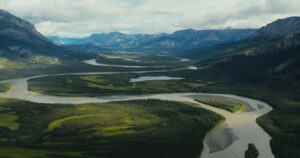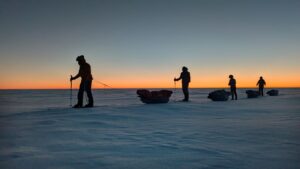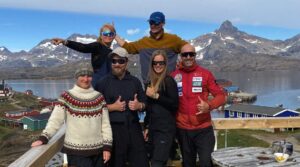In 1992, I hopped a bush plane and flew from Rankin Inlet to Ferguson Lake, Keewatin (now Nunavut). After I climbed out of the plane, black flies began mobbing my every available pore, then drinking from my fountain. “Welcome to Ferguson Lake!” my Inuit guide Willie said with a wry grin on his face.
Here’s the good news. As soon as I set out with Willie to explore the local tundra, a meek wind became a strong one, and the black flies departed for parts unknown. I should mention that this section of Keewatin was itself a part unknown until 1894, when explorer Joseph Burr Tyrrell discovered Ferguson Lake during his Geological Survey of Canada Expedition. Speaking of geology, a mining company has recently announced a plan to do exploratory drilling for nickel, copper, and platinum in the vicinity of Ferguson Lake. Not good news at all…at least not for the environment.
I had traveled here not only to escape the throes of civilization, but also to document the local fungi. After an hour or so, I saw several small, black, pear-shaped Sporormiella fruiting bodies sticking out of some muskox dung. Fossilized Sporomiella spores have been found in the fossilized dung of mammoths, and as I gazed at this not particularly charismatic species, I felt like I was in the presence of something primordial.
Coincidentally, I saw a muskox standing perhaps 150 feet away from us, and not far from the muskox was an Inuit burial cairn. That critter is always hanging out here, Willie told me. The reason why, according to elders, is that the cairn’s occupant was an angakok (shaman) who commonly transformed himself into a muskox. Willie warned me not to take a photo of either the muskox or the cairn, lest I anger the angakok.
“What would happen if I did anger him?” I inquired.
“I might have to build a burial cairn for you” was the answer.
This area would be a really nice final resting place, I thought, but since I had no wish to undergo a premature burial, I kept my camera in my rucksack.
The wind suddenly died down and out came the black flies again. “God help us!” I exclaimed. But my request didn’t receive an answer. Perhaps the Supreme Being’s bailiwick didn’t include this remote section of the Arctic, or maybe he had no wish to engage in battle with rival lords (aka black flies).
I asked Willie what the local Inuit did to ward off black flies and mosquitoes. We don’t wash ourselves, he said, and then they can’t detect us because our skins are covered with dirt and grime. Unfortunately, I’d taken a shower that morning before I got on the plane, so I now had no choice but to anoint my skin with citronella oil.
Near the lake, I noticed a relatively large, brownish-white mushroom half-buried in sphagnum moss. Maybe a Russula or Lactarius species? I thought. On closer inspection, it turned out not to be a mushroom, but a very old coffee mug. Could this mug be an artifact from the Tyrrell Expedition? I wondered. Maybe Robert Monro Ferguson, an avid sportsman and a member of that expedition (the lake is named after him), had seen a caribou and left the mug behind in his haste to run off and shoot it? But Ferguson was a Scotsman, so he probably drank tea rather than coffee. Another mystery in the history of exploration.
It was early evening, and a plague of mosquitoes now replaced the black flies. After Willie and I planned tomorrow’s outing, I walked toward my tent. The silence of the surrounding tundra was so complete that I could hear the mosquitoes calling my name.





